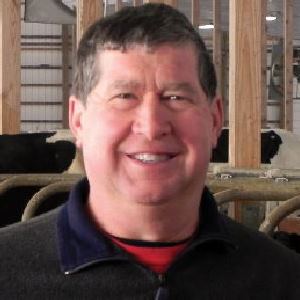Healthy and Happy Start at Day One

 |
Rendell Tullar
Orford, N.H.
Tullando Farm, a 550-cow herd of registered Holsteins in the Connecticut River Valley, is heading toward a robotic milking future.
We are in the middle of what seems to be an old-fashioned winter. Many mornings have been well below zero, and brutally cold winds make it seem even colder.
We are writing about how we keep our animals healthy, happy and ready to breed. We will start with happy. Everything starts with day one of their lives. New calves receive 6 qts. of colostrum within the first six hours of birth. They are taken to a warming hutch (in the cold weather) or to their hutch bedded with shavings and straw. They are fed whole milk three times a day with free choice grain and water.
We have put major emphasis on our housing and keeping our animals comfortable while indoors.
At seven weeks, the calves are moved in small groups (usually nine calves) to the freestall calf barn. They’re introduced to a total mixed ration that’s topdressed with the same calf grain that they received in the hutches. The calf freestalls have rubber mattresses and are bedded with our own separated manure solids, which are used on day four after heating to 140°F.
This barn also has automated alley scrapers and automatic curtains for ventilation. Killed vaccines are given at five and six months with a modified live vaccine given at 10 months. Our goal is to have the calves leave this barn at 11 months of age in groups of 25 to 30.
Their next housing has the same comforts and heat detection starts. Breeding begins at 12 months of age. At this stage, heifers should be 56" tall and weigh at least 750 lb. Each animal is bred AI using calving ease sires, which are either high-genomic young sires or high TPI-proven sires. After 30 days, they are pregnancy checked. At 15 to 16 months, they are moved to housing for dry cows eventually being moved to a springer group six weeks before they are due to calve.
We have separate groups for the springers. One group is for heifers calving the first time, and one group is for cows. Each animal is given two vaccinations of J5 at two- to three-week intervals and their feet are trimmed.
Springers are moved to a small group pack area two to three days before they calve. After calving, they are moved to a fresh cow group with a feed ration that has a TMR formulated for them with 0.5 lb. of straw and added minerals. They are vet-checked at 45 to 55 days to make sure they are ready to be bred at 60 days. Springers are revaccinated with modified live vaccine at 15 to 30 days fresh.
From here, these cows go to one of three groups: a first-calf heifer group, a young cow or smaller cow group or a large, older cow group. We do this so that the freestalls are sized accordingly to animal size. All stalls are bedded with kiln-dried shavings on mattresses.
Milking cows have their feet trimmed twice a year: once at dry-off and again at mid-lactation. When dried off, cows are vaccinated with a J5 killed vaccine.
Additionally, plenty of fresh water is in front of all groups in all barns, all the time. Our tubs are cleaned on a rotating basis, with some being cleaned daily. We also pasture older bred heifers and dry cows during the summer months.
I want to go back and emphasize two topics that we feel are very important to our program: 1) heat detection, because we breed 95% of the cows and all heifers off natural heats, and 2) the use of calving ease sires on the heifers so they calve with the least amount of problems possible.
We believe that by following these procedures and paying attention to the little everyday details, it keeps happy cows healthy and ready to breed back.
Tullar’s recent prices
Milk
$21.10 (3.75 bf, 3.1 prt)
Cull cows
$72/cwt.
Springing heifers
$1,500 to $1,800/head
Cottonseed
$370/ton
Ground corn
$196/ton







